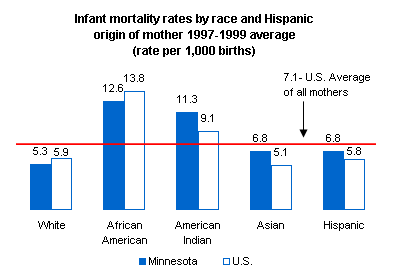
HEALTH SYSTEM FOR THE NEXT 50 YEARSAlthough Minnesota's health system is generally admired, it can and should be strengthened for the future. There are still too many uninsured Minnesotans, including approximately 64,000 children. The uninsured either go without care and compromise their health, or they get care in the most uneconomical ways - ultimately paid for by insured citizens and taxpayers. Not only is this system uneconomical, but it is increasingly fragile, with the safety net at risk of collapse as health care institutions are financially squeezed. The health system must invest more heavily in and reward prevention, not just treatment. We must help refocus the system on producing better health status for all Minnesotans, not just on producing more and costlier services that fewer and fewer people can afford. Given the stresses on the health system today, and the coming demographic challenges of a more diverse, rapidly aging population, we need a vision of a new health system built not for the last 50 years, but for the next 50 years. Lead Departments: Minnesota Department of Health, Minnesota Department of Human Services |
||||||||||||||||||||||
The Big Accounting Initiative
Score Goal: All Minnesotans have access to health insurance coverage. Reduce uninsurance rates.Goal: All Minnesota children have access to health insurance coverage. Reduce uninsurance rates for children 18 and under.Goal: All newborns are healthy. Reduce infant mortality rates in every racial/ethnic population.Goal: Everyone living healthy into old age. Increase the percentage of adults who exercise on a regular basis.Goal: Everyone has access to high quality health care. Improve the quality of and access to health care. (Under Construction) |
||||||||||||||||||||||

|
||||||||||||||||||||||
| Reduce uninsurance rates. | ||||||||||||||||||||||
 |
|
|||||||||||||||||||||
Note: This indicator measures the percentage of Minnesota residents who lack health insurance coverage at any given point in time. Baseline information on the number of uninsured Minnesotans comes from the 2001 Minnesota Health Insurance and Access Survey, sponsored by the Minnesota Department of Health and conducted by the University of Minnesota, School of Public Health. Research consistently shows that not having health insurance is one of the key reasons people either postpone seeking medical attention or simply do not get health care when they need it. In 2001, 5.4 percent of Minnesotans (about 266,000 people) did not have health insurance coverage. Characteristics and Trends Among Minnesota's Uninsured Population http://www.health.state.mn.us/divs/hpsc/hep/issbrief/uninsure.pdf 2001 Minnesota Health Access Survey Results http://www.health.state.mn.us/divs/hpsc/hep/hrsa/april.pdf National Center for Health Statistics: Health Insurance Coverage http://www.cdc.gov/nchs/fastats/hinsure.htm Bureau of the Census: Health Care Coverage http://www.census.gov/prod/2001pubs/p60-215.pdf Minnesota's Uninsured: Findings from the 2001 Health Access Survey http://www.health.state.mn.us/divs/hpsc/hep/miscpubs/other.htm |
||||||||||||||||||||||
| top
|
||||||||||||||||||||||
| Reduce uninsurance rates for children 18 and under. | ||||||||||||||||||||||
 |
|
|||||||||||||||||||||
Note: This indicator measures the percentage of children 18 and under in Minnesota who lack health insurance coverage at any given point in time. Baseline information on the number of uninsured children comes from the 2001 Minnesota Health Insurance and Access Survey, sponsored by the Minnesota Department of Health and conducted by the University of Minnesota, School of Public Health. While health insurance coverage is only one aspect of children's health, it is important for assuring that children get health care when it is needed-especially preventive care. In 2001, 4.7 percent of Minnesota children 18 and under (approximately 64,000 children) did not have health insurance coverage. DHHS Insure Kids Now http://www.insurekidsnow.gov/ HHS SCHIP http://www.hhs.gov/news/press/2001pres/01fsschip.html Health Insurance in general for consumers: MedlinePlus: Health Insurance http://www.nlm.nih.gov/medlineplus/healthinsurance.html Health Insurance Association of America: Consumer Information http://www.hiaa.org/cons/cons.htm The 2001 Legislature approved a Ventura administration proposal to extend health care coverage to up to 20,000 low-income children by 2005. Learn more at: http://www.dhs.state.mn.us/newsroom/facts/session/sfscoverkids.htm |
||||||||||||||||||||||
| top
|
||||||||||||||||||||||
| Reduce infant mortality rates in every racial/ethnic population. | ||||||||||||||||||||||
 |
||||||||||||||||||||||
|
Note: Infant mortality is defined as the death of a live-born infant before age 1. Because of small numbers of actual events, data are grouped and analyzed as three-year running averages. Although Minnesota's overall infant mortality rate is low, that average hides the fact that infant death rates in some populations, such as American Indians and African Americans, are much higher. As defined in legislation, the state's target for 2010 is to reduce the disparities between rates for these populations and rates for whites. A healthy birth is dependent on many factors: the mother's health before pregnancy; family social support; poverty; quality and content of prenatal care; nutrition during pregnancy; violence and injury; and use of substances such as tobacco, alcohol and drugs. Eliminating Health Disparities: Infant Mortality http://www.health.state.mn.us/facts/disparitiesinfant.pdf Healthy Minnesotans Special Report Infant Mortality http://www.health.state.mn.us/divs/chs/healthmnvol1c.pdf#infant MMWR: Achievements in Public Health, 1900-1999: Healthier Mothers and Babies http://www.cdc.gov/mmwr/preview/mmwrhtml/mm4838a2.htm Zero to Three http://www.zerotothree.org/ National SIDS Resource Center: http://www.sidscenter.org March of Dimes Resource Center http://www.modimes.org National Healthy Start Association http://www.healthystartassoc.org National Institute of Child Health and Development http://www.nichd.nih.gov/ |
||||||||||||||||||||||
| top
|
||||||||||||||||||||||
| Increase the percentage of adults who exercise on a regular basis. | ||||||||||||||||||||||
 |
|
|||||||||||||||||||||
|
Note: Regular physical activity reduces all kinds of long-term risks to health, such as overweight and obesity, heart disease and stroke, arthritis, diabetes, osteoporosis, high blood pressure, and cancer. Unfortunately, for many reasons, the number of adults who do not get regular physical activity has been steadily going up. This indicator comes from the Behavioral Risk Factor Surveillance Survey, an annual telephone survey of the health-related behaviors of Minnesota residents. Regular physical activity on this survey was defined as exercising five or more times per week, for 30 minutes or more per session, regardless of intensity. Because the percent of adults reporting no physical activity has been increasing in the last decade, the goal is to slow or stop that trend. Physical Activity and the Older Adult http://www.health.state.mn.us/divs/fh/chp/Older/Images/PAOA.pdf Let's go for a walk http://www.health.state.mn.us/divs/fh/chp/walk.pdf Activity Choices for Older Adults http://www.health.state.mn.us/divs/fh/chp/npa/older.html Exercise Made Easy: Physical activity for older adults http://www.health.state.mn.us/divs/fh/chp/npa/seniors.html National Institute on Aging: Exercise: Feeling Fit for Life http://www.nia.nih.gov/health/agepages/exercise.htm National Institute on Aging: Exercise: A guide from the National Institute on Aging http://www.nia.nih.gov/health/pubs/nasa-exercise/ |
||||||||||||||||||||||
| top
|
||||||||||||||||||||||
| Improve the quality of and access to health care. (Under Construction) | ||||||||||||||||||||||
Note: This indicator is under construction. No statewide measure currently exists to evaluate health care quality. Health care quality problems reduce the effectiveness and drive up the costs of the health care system. Improving the quality of care can significantly reduce overall costs by reducing medical errors, eliminating unnecessary procedures, and stepping up efforts at prevention. Minnesota Department of Health Fact Sheet: Center for Health Quality http://www.health.state.mn.us/facts/mchq.pdf |
||||||||||||||||||||||
| top
|
||||||||||||||||||||||
